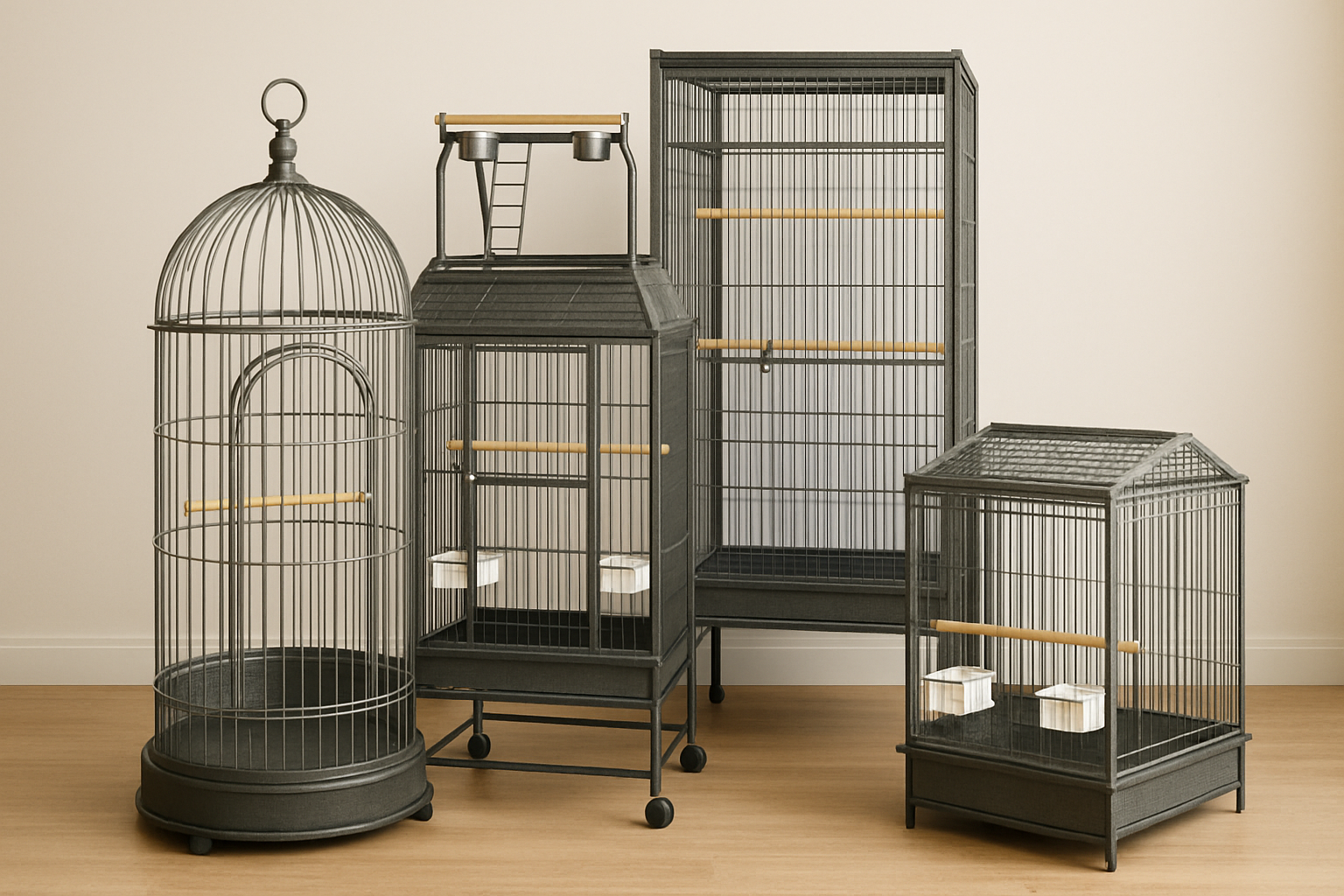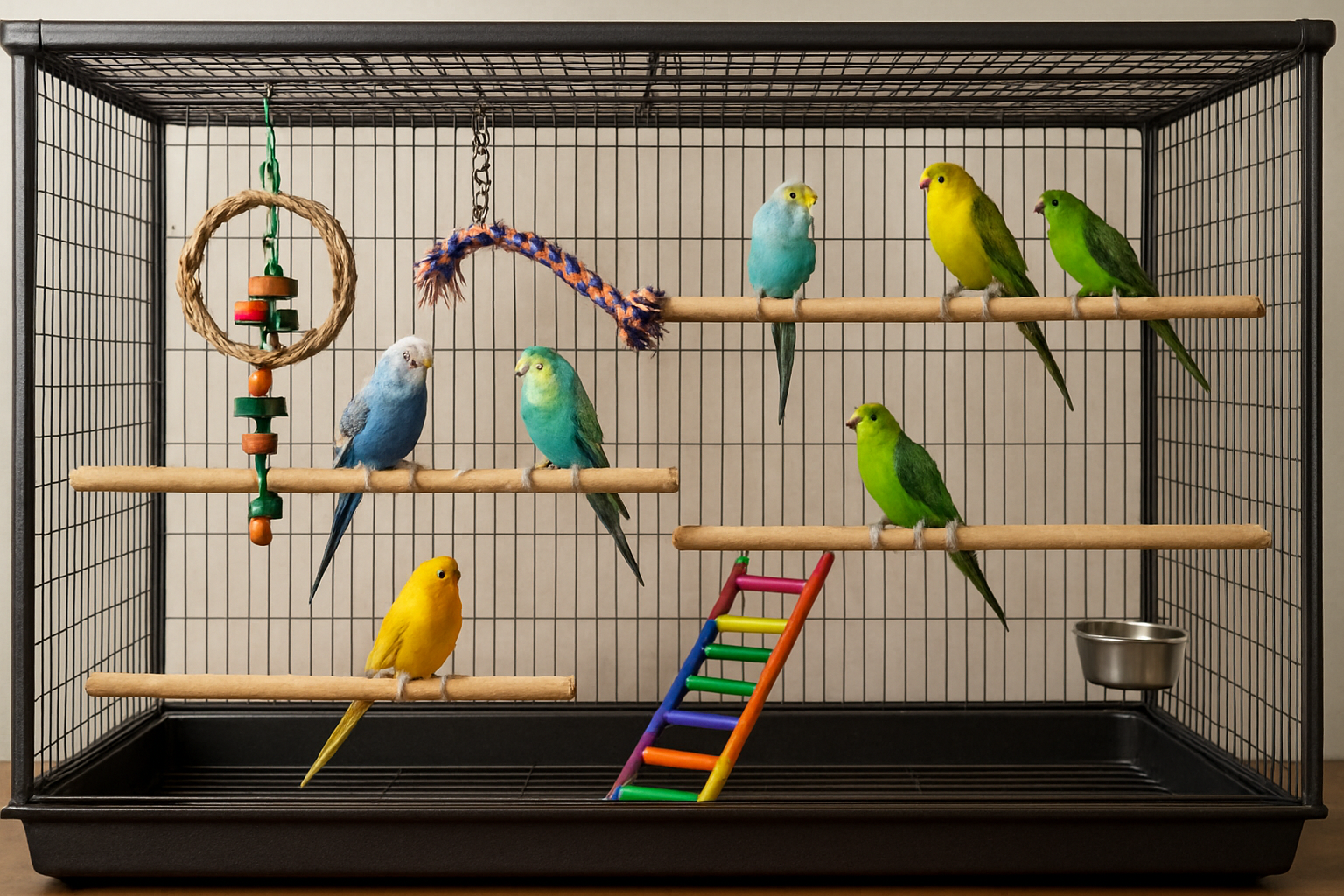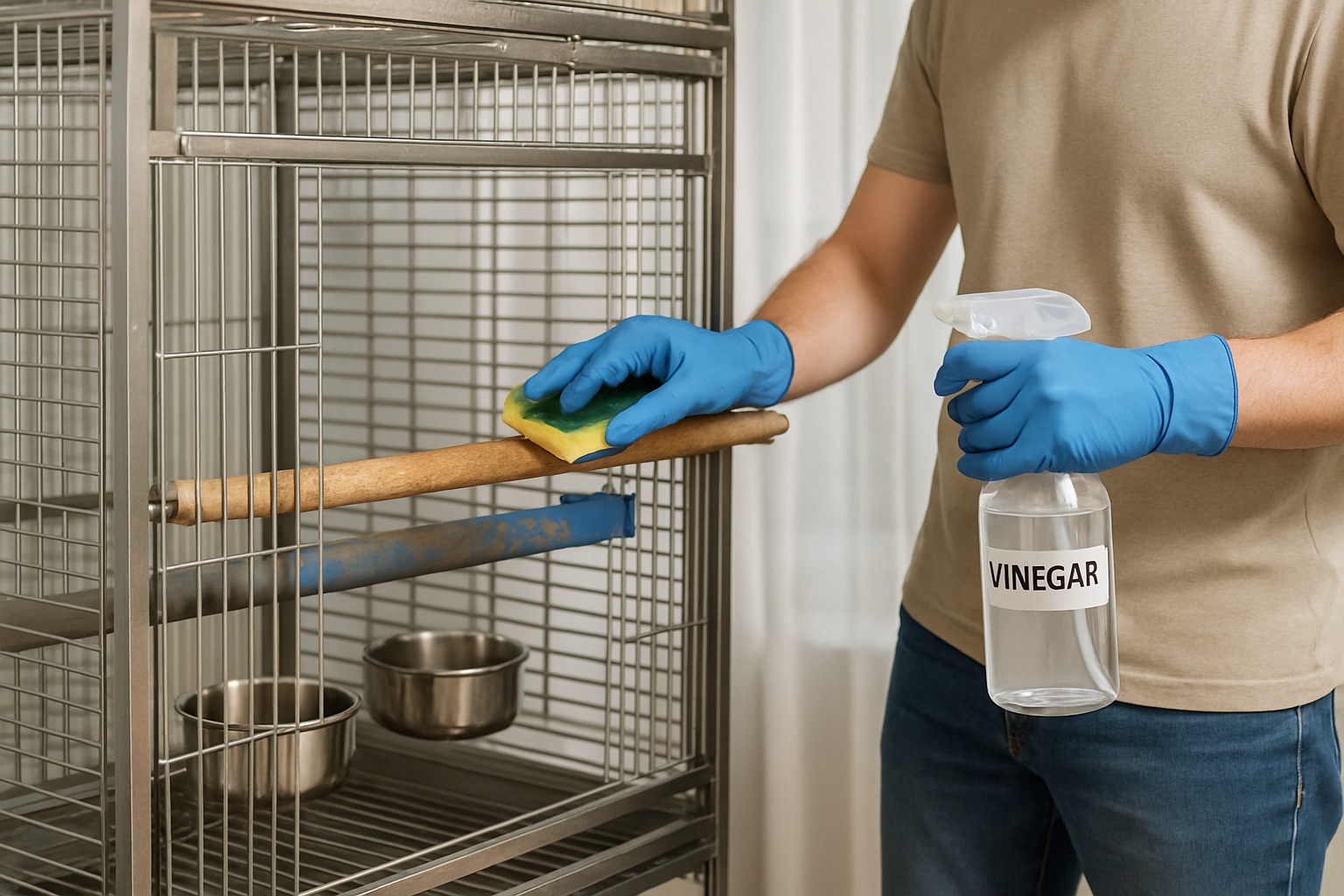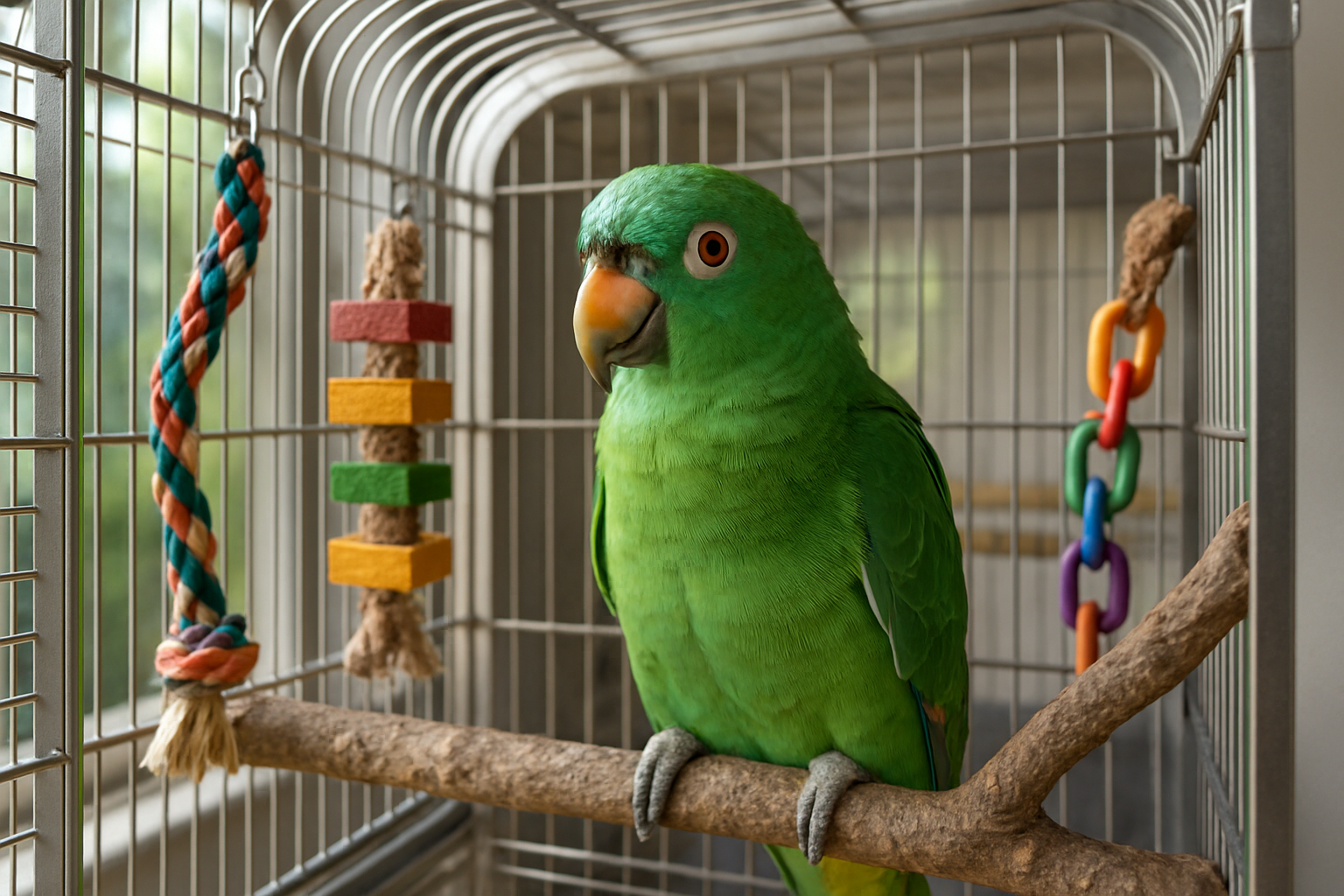A bird cage is not just a home; it's a sanctuary for your feathered friend.
But what makes a bird cage truly perfect?
This comprehensive guide is your cheat sheet to choosing, maintaining, and enjoying the best bird cage for your pet.
Some are spacious enough to let your bird stretch its wings and take short flights.
Some are designed with special materials to ensure durability and safety.
Some come with innovative features like play tops or removable trays for easy cleaning.
Some are tailored specifically for certain species, from tiny finches to large macaws.
Some cages optimize your living space without compromising your bird’s comfort.
Let's dive right in.
Table of Contents
- Why the Right Bird Cage Matters
- Types of Bird Cages
- Key Features to Consider When Choosing a Bird Cage
- Ideal Bird Cage Sizes for Different Species
- Materials and Safety Considerations
- Cleaning & Maintenance Routine for a Healthy Bird Cage
- Accessories and Enrichment Essentials
- Bird Cage Placement and Environmental Tips
- Frequently Asked Questions
- What's Your Next Step?
Why the Right Bird Cage Matters
Choosing the perfect bird cage is the cornerstone of responsible bird ownership. A suitable cage goes beyond containing your pet — it provides a secure, stimulating environment where birds can eat, play, rest, and flourish. In the wild, birds enjoy vast open spaces to fly, forage, and nest. In captivity, the cage is their universe. Therefore, ensuring it mimics these needs as closely as possible is crucial for their physical and mental well-being.
Unsuitable cages can lead to issues like feather plucking, stress, and physical injuries. For example, a cage that is too small or narrow restricts flight, often causing boredom and behavioral problems. On the other hand, a cage too large but difficult to maintain may compromise hygiene and safety.
That’s why selecting the right bird cage encompasses understanding your bird’s specific needs, species behavior, and even personality quirks.
Did you know? Birds with long tails, such as macaws and cockatoos, need taller cages to prevent tail damage. Horizontal space is more important than height especially for active birds that fly side to side within their cage.
Types of Bird Cages
Bird cages come in an array of styles designed for different purposes and bird types. Understanding these will help you match your bird’s lifestyle and your space.
Aviaries and Flight Cages
These are large enclosures that allow birds to fly short distances and engage in natural behavior. Aviaries often house multiple birds and offer space for perches, toys, and flight. Flight cages are similar but generally smaller, suitable for one to a few birds. Both provide excellent exercise opportunities.
Breeding Cages
Equipped with side doors for nest boxes, these cages facilitate breeding but can double as pet cages. They are convenient, but owning a breeding cage doesn’t automatically induce breeding behavior in your bird.
Tabletop Cages
Compact and portable, these cages sit on tables or countertops. They are ideal for small birds like canaries or finches and for temporary housing during cleaning or travel.
Dome and Dome-Top Cages
These cages feature curved tops, providing additional vertical space. The dome shape can create a cozy interior atmosphere and sometimes includes top doors, offering your bird an alternative exit and play area.
Play-Top Cages
Play-top cages have an integrated play area on top, combining a cage and stand into one. This design fosters interaction and enrichment but can be challenging for territorial birds.
Stack and Double Cages
When space is limited, stack cages or double cages with removable dividers provide flexibility for housing multiple birds or separating birds temporarily.
Quarantine and Sleep Cages
Quarantine cages temporarily isolate new or sick birds to prevent disease spread. Sleep cages are smaller, designed for nighttime rest without distractions, promoting better sleep quality.
Show and Transport Cages
Show cages are decorative and used for competitions, while travel cages prioritize portability and bird safety during transport or vet visits.
Before you make a choice, check out an insightful guide on picking a good cage to help narrow your options.

Key Features to Consider When Choosing a Bird Cage
Choosing the right bird cage goes beyond style; it’s about details that affect your bird’s comfort, safety, and your convenience.
- Size and Space: Minimum cage size should be at least twice the bird’s wingspan in width. Depth and height also matter, especially for species with long tails or that prefer climbing. Remember: bigger is always better if space allows.
- Bar Spacing and Thickness: Bar spacing must be appropriate to prevent escapes or injuries. For example, small birds like finches need spacing between ¼ to ½ inch, while large macaws require 1 to 1.5 inches. Bars should be thick and sturdy enough to withstand biting and climbing.
- Bar Orientation: Horizontal bars facilitate climbing for many birds; vertical bars may be less commonly used for climbing. Some cages combine both to enhance activity options.
- Material: Stainless steel cages are safest, rust-free, and durable, but often costlier. Powder-coated cages are affordable and colorful but may chip over time, exposing birds to harmful metals if coatings are older or toxic. Avoid cages with zinc or lead coatings. Aluminum, wrought iron, acrylic, and wood all have pros and cons; wood is porous and hard to clean.
- Ease of Cleaning: Look for cages with removable trays, grates, and large doors. Plastic liners under cages and pull-out trays help keep surrounding areas tidy. Food bowls with exterior access save time. Avoid cages without removable parts as they increase cleaning difficulty.
- Door Design: Large front or swing-out doors provide easier access for cleaning and bird removal. Avoid slide-up or guillotine doors unless locked securely, as they can harm birds or allow escapes.
- Accessories Included: Some cages come with perches, food/water dishes, and seed guards which help keep the area clean. Make sure all accessories are bird-safe and replaceable.
- Cage Placement Options: Does the cage include casters for mobility? Will it fit on a table stand or does it have an integrated stand? Consider your intended setup thoroughly.
Inside scoop: The width of the cage is more important than height for active birds, making rectangle cages a superior choice compared to tall narrow ones or round cages, which decrease usable space and increase injury risk.
Learn more about best cleaning habits for bird cages in our detailed bird cage maintenance guide.
Ideal Bird Cage Sizes for Different Species
Not every bird thrives in the same sized cage. Here are minimum inside dimensions recommended for popular species (length x depth x height in inches):
- Finches: 30 x 18 x 18
- Budgies & Canaries: 24 x 18 x 18
- Cockatiels & Green Cheek Conures: 20 x 20 x 24
- Lovebirds & Parakeets: 24 x 18 x 24
- Diamond Doves: 24 x 24 x 24
- Larger Conures & Senegal Parrots: 24 x 24 x 24
- Ringnecks, Caiques, Pionus & Jardines: 24 x 24 x 36
- Amazons, Mini Macaws, Small Cockatoos & African Greys: 36 x 24 x 48
- Large Cockatoos: 48 x 36 x 48
- Large Macaws: 48 x 36 x 60
Remember, these are minimums. Providing a larger cage whenever possible is always beneficial for your bird’s happiness and health.
If you keep multiple birds, ensure the cage is proportionally bigger to accommodate social interaction and movement without crowding.

Materials and Safety Considerations
The safety of your bird is paramount when selecting cage materials. Here's an expert breakdown:
- Stainless Steel: The gold standard for durability, safety, and ease of cleaning. Resistant to rust, corrosion, and is non-toxic. Ideal for all bird sizes but premium in price.
- Powder-Coated Steel: Affordable and available in many colors. Make sure the coating is non-toxic and intact as chipping can expose harmful metals.
- Aluminum: Lightweight, rust-resistant, and durable but softer than steel bars. Suits smaller birds better.
- Wrought Iron: Durable but vulnerable to rust if exposed to moisture. Should be treated for safety.
- Wood: Mostly for small, non-destructive birds. Difficult to clean and porous, posing risks for bacteria buildup. Not suitable for chewers.
- Acrylic: Offers a great view and aesthetic appeal but limits climbing and toy placement. Also harder to clean and restricts air circulation.
Critical Note: Avoid cages manufactured before 1978 with zinc or lead coatings due to poisoning risks. Always inspect used cages for chips, rust, or damage before purchase.
For reassurance about material choices and cage safety, it's wise to consult trusted communities such as parrot owner groups on Reddit.
Cleaning & Maintenance Routine for a Healthy Bird Cage
Maintaining a clean bird cage is vital for your pet’s health. Accumulated droppings, food debris, and mold can cause illness and respiratory issues.
Daily Cleaning Tasks
- Replace the cage liner every day. Use newspaper or other paper liners that allow droppings to be visible and easily disposed of.
- Wash food and water dishes with hot soapy water, rinse thoroughly, and dry completely to prevent mold growth.
- Clean any birdbaths inside the cage with a bird-safe disinfectant and remove droppings from perches and toys.
- Sweep or vacuum the floor under the cage to remove seeds, feathers, and other debris. Using a plastic liner under the cage can help contain mess.
Weekly and Monthly Deep Cleaning
- Remove your bird safely and place it in a temporary habitat.
- Take out all toys, perches, and accessories. Clean them with bird-friendly cleaners or hot soapy water. Sandpaper can help remove stubborn droppings from wooden items.
- Scrub the cage with hot, soapy water; rinse thoroughly and dry completely before reassembling.
- Wash and disinfect the surrounding cage area, including seed guards, trays, and floor liners.
- Rotate toys and perches to keep the environment stimulating and hygienic.
Cleaning frequency depends on bird species, cage size, and bird activity. Smaller birds may be fine with monthly deep cleaning, but weekly is recommended for larger or multiple birds.
Quick tip: Store all cleaning supplies in a portable caddy near your cage for hassle-free maintenance. Vinegar diluted with water or baking soda paste are safe and effective cleaning agents.

Accessories and Enrichment Essentials
Keeping your bird mentally and physically stimulated is a key part of cage setup. Here’s what to include in your bird cage:
- Perches: Use different sizes and textures (wood, rope) to encourage foot exercise and prevent sores. Avoid uniform perches; variation is key.
- Toys: Birds need toys for play and chewing to prevent boredom. Include chewable wood toys, foraging toys, and puzzle feeders. Rotate them to maintain interest.
- Food and Water Dishes: Opt for stainless steel or safe plastic dishes that are easy to clean and prevent mold formation.
- Calcium Sources: Include cuttlebones or mineral blocks to supplement bird nutrition and beak health.
- Bird Baths: Some birds enjoy bathing inside the cage; a shallow bird bath encourages this.
Some birds are territorial—if yours is, watch how they react to playtop cages or accessories placed outside the cage. Adjust accordingly to suit your bird’s personality and behavior.
Learn more about bird enrichment ideas from the parrot owner community.
Bird Cage Placement and Environmental Tips
Proper location of your bird cage within your home is often overlooked, yet it greatly influences your bird’s comfort and safety.
- Noise Levels: Place the cage where your bird can engage with family members but avoid noisy appliances or loud music that may cause stress.
- Sunlight and Drafts: Avoid direct sunlight that can overheat, and steer clear of drafty spots. A steady temperature is ideal.
- Visibility: Birds are social and like to observe activity. Position the cage at eye level if possible to foster interaction.
- Safety: Keep cages away from kitchens, toxic fumes, open windows, ceiling fans, and from predators like cats and dogs. Use sturdy cage stands or secure tabletops.
- Lighting: Natural light supports circadian rhythms but avoid harsh lighting. For indoor birds, consider full-spectrum lighting as necessary.
By thoughtfully placing the cage, you enrich your bird’s environment, encouraging natural behavior and bonding.
Frequently Asked Questions
How often should I clean my bird cage?
Daily light cleaning (liners, dishes, droppings spot clean) is essential. A deep clean with cage and accessories wash is recommended weekly or monthly, depending on bird size and number (source).
Is a bigger cage always better?
Yes. Larger cages provide space for flying, playing, and perching. It’s better for physical health and reduces behavioral issues. However, it should suit your living space and be manageable for cleaning.
Can I use a round cage?
Generally, no. Round cages limit horizontal space and can cause injury as birds may get toes or feathers stuck where bars converge. Large, well-spaced round aviaries are exceptions, otherwise rectangular or square cages are recommended.
What are the best materials for safe bird cages?
Stainless steel tops the list for durability, safety, and low maintenance. Powder-coated steel is the next best, followed by aluminum. Avoid old or damaged cages that may contain toxic coatings.
Should I include toys inside a cage?
Absolutely. Toys provide mental stimulation and physical exercise which are vital for a bird’s happiness and health. Rotate toys regularly to keep your bird engaged.
What's Your Next Step?
Tell us in the comments: How will you apply this to your bird cage selection and care? For personalized advice, contact us!
Interested in enhancing your pet's environment? Explore our big bird cages and aviaries for sale to find a perfect fit that offers safety and style.
Curious about cage designs and tips? Watch this detailed video for expert insights and visuals:
Remember, a great bird cage transforms your feathered friend’s life into a happy, healthy adventure. Take the time to choose, maintain, and enrich your bird’s space and watch their personality shine.

For inspiration on matching your bird’s needs with the perfect cage, check out this useful discussion on pairing cages with bird species.




